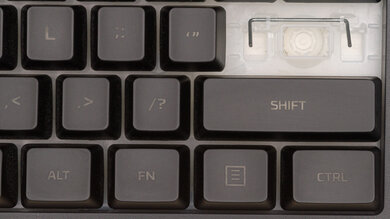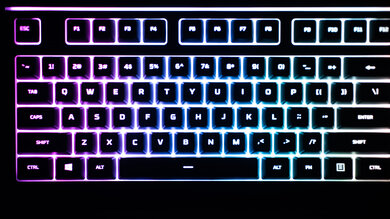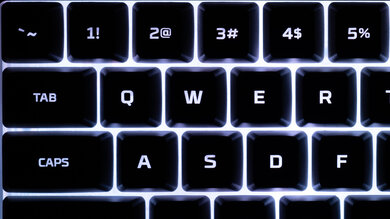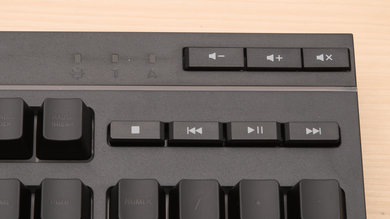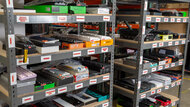The HyperX Alloy Core RGB is a poor gaming keyboard. Its rubber dome switches feel unresponsive due to their high pre-travel distance, and the absence of programmable keys and software support is disappointing as well. However, its quiet typing noise makes it suitable for noise-sensitive work environments, and it has good compatibility with most desktop operating systems. On the whole, it doesn't feel much different from an average office keyboard and may be a good option for those on a tight budget.
Our Verdict
The HyperX Alloy Core RGB is a poor keyboard for gaming. The keys have a high pre-travel distance that can feel unresponsive, and the keyboard doesn't have any dedicated macro keys for MMO games. As there's no software support or onboard memory, gamers won't be able to save profiles. The RGB backlight is great for gaming in a dark room, however, customization is limited to presets only.
-
Good compatibility.
-
Dedicated media keys.
-
No software support for customization.
-
Rubber dome switches can be tiring.
The HyperX Alloy Core RGB is a wired-only keyboard and can't be used with mobile devices.
The HyperX Alloy Core RGB is decent for office use. The keys have a low actuation force that feels light and shouldn't cause any fatigue. Although the keyboard doesn't have a particularly high profile, you may still need a wrist rest for optimal comfort, and there isn't one included in the box. Fortunately, typing noise is kept to a minimum, so you won't have to worry about bothering your surrounding colleagues.
-
Good compatibility.
-
Dedicated media keys.
-
No software support for customization.
-
Rubber dome switches can be tiring.
The HyperX Alloy Core RGB is a sub-par keyboard for programming. The keys are easy to press, but they feel unresponsive and can be fatiguing when typing for a long time. The lack of programmable macro keys can be frustrating and its backlight has limited customizability.
-
Good compatibility.
-
Dedicated media keys.
-
No software support for customization.
-
Rubber dome switches can be tiring.
-
Good compatibility.
-
Dedicated media keys.
-
No software support for customization.
-
Rubber dome switches can be tiring.
- 6.8 Gaming
- 0.8 Mobile/Tablet
- 6.5 Office
- 6.2 Programming
- 3.0 Entertainment / HTPC
Changelog
- Updated May 12, 2023: We've converted this review to Test Bench 1.2. This update introduces new Backlight Features and Backlight Clarity test boxes. We've also added a new Switches test box, added additional test comparisons to our Hardware Customizability test box that we introduced with our last Test Bench. For an in-depth look at our changes, you can see our full changelog here.
- Updated Apr 26, 2023: We've converted this review to Test Bench 1.1. This update adds several new tests addressing Hardware Customization, Macro Keys And Programming, and Wireless Mobile Compatibility. We've also added new objective evaluations to the Typing Noise test, and we've simplified several tests and removed several others that were no longer relevant. For an in-depth look at all our changes, you can see our full changelog here.
- Updated Apr 14, 2021: Converted to Test Bench 1.0.
- Updated Feb 10, 2020: Review published.
- Updated Jan 30, 2020: Early access published.
Check Price
Differences Between Sizes And Variants
There are no other variants of this keyboard. The other keyboards in the HyperX Alloy lineup all have mechanical switches instead of rubber domes.
Compared To Other Keyboards
The HyperX Alloy Core RGB is a budget keyboard with rubber dome switches and shouldn't be compared to other mechanical gaming keyboards. Overall, it feels like a regular office keyboard with basic RGB backlighting and is very similar to the Razer Cynosa Chroma. For other options, check out our recommendations for the best gaming keyboards, the best keyboards for writers, and the best RGB keyboards.
The SteelSeries Apex 3 is much better than the HyperX Alloy Core RGB. The SteelSeries has a significantly better build quality, typing experience, and ergonomics. Also, it comes with a wrist rest, and the keyboard is much more customizable since every key can be reprogrammed and has software support, which the HyperX doesn't have.
The Corsair K55 RGB and the HyperX Alloy Core RGB are both non-mechanical gaming keyboards with rubber dome switches and similar typing qualities. That said, the Corsair has is a better overall keyboard with several additional features, including a wrist rest for better ergonomics, macro programmable keys, and companion software for customization.
Overall, the Logitech G213 Prodigy is much better than the HyperX Alloy Core RGB. The Logitech is more comfortable due to the built-in wrist rest, has macro-programmable keys, and software support for customization. However, the HyperX has a better build quality and brightness control for its backlighting.
The HyperX Alloy Origins is a significantly better keyboard than the HyperX Alloy Core RGB. The Alloy Origins has a much better build quality due to its full aluminium frame, and it has mechanical switches that provide a much better typing experience. Also, the Alloy Origins has software support for customization, however, the Alloy Core makes slightly less noise when typing, which is more suitable for noise-sensitive environments.
The HyperX Alloy FPS Pro is much better than the HyperX Alloy Core RGB. The Alloy FPS Pro has mechanical switches that feel much more responsive than the rubber dome switches found on the Alloy Core, and it has a significantly better build quality. The Alloy FPS Pro has individually lit backlighting instead of the zone lighting of the Alloy Core, but the Alloy Core has dedicated media keys.
The Redragon K552 KUMARA RGB is a much better keyboard than the HyperX Alloy Core RGB. The Redragon has mechanical switches that provide a better typing experience, though the clicky switches may be bothersome for some. The Redragon has a significantly better build quality, and its RGB backlighting has more customization options; however, it may not be the best choice if you like having a NumPad, as the Redragon is a tenkeyless keyboard.
The HyperX Alloy Core RGB and the Corsair K55 RGB PRO are similar wired keyboards with rubber dome switches, but the Corsair is a much better gaming keyboard. The Corsair has significantly lower latency, six dedicated macro keys, and all its keys are macro-programmable. It also has five RGB backlighting zones and companion software compatible with Windows and macOS for customization. On the other hand, the HyperX lacks a wrist rest, none of its keys are macro-programmable, and while it has five RGB backlighting zones, it has no companion software for customization.
The Razer Cynosa Chroma and the HyperX Alloy Core RGB are similar keyboards in most uses, as they're both budget membrane keyboards with RGB backlighting. The only real difference is that the Razer has more customization options due to its software support, and the HyperX has dedicated media keys instead of hotkeys.
The Logitech K840 is significantly better than the HyperX Alloy Core RGB. The Logitech has a better build quality thanks to its aluminum plate, and it has mechanical switches that feel light and responsive. The Logitech has software support for customization, but it doesn't have dedicated media keys like the HyperX, and typing noise can be louder if you bottom out the keys.
Test Results
The HyperX Alloy Core RGB is a large, full-size keyboard with an added row of dedicated media keys at the top. If you prefer a more compact keyboard, check out the HyperX Alloy FPS Pro, which is a tenkeyless (TKL) keyboard.
The build quality is okay. The keyboard has a full plastic frame that exhibits quite a bit of flex, and the keycaps are made of ABS plastic, which feel cheap. The rubber dome switches are mediocre, but slightly better than the ones found on the Razer Cynosa Chroma. HyperX advertises this keyboard as being spill-resistant, though this isn't something we test for. If you want a keyboard with better build quality, check out the SteelSeries Apex 3.
The HyperX Alloy Core RGB's ergonomics are decent. It doesn't have a particularly high profile and the keys have a fairly standard spacing. It has one incline setting; however, it doesn't come with a wrist rest, though you can purchase one separately from HyperX. If you want a similar keyboard that comes with a wrist rest, check out the Logitech G213 Prodigy.
There are five lighting zones, and customization is done on the keyboard, since there's no software support. There are 10 color presets and six lighting effects to choose from, one of which is a rainbow effect, as shown in the picture. If you want a similar keyboard with individually-lit keys, check out the Razer Cynosa Chroma.
The keyboard has a braided cable and it's not detachable.
This is a wired-only keyboard.
There are dedicated media keys at the top right corner of the keyboard. At the top left corner, there are keys to control the backlight, as well as a 'Game Mode' key, which locks the Windows key to prevent accidentally minimizing your game. If you're interested in a similar gaming keyboard with macro-programmable keys, check out the Corsair K55 RGB PRO.
This keyboard uses rubber dome switches.
Although it doesn't take much force to actuate the keys, there's a fairly big hump to get over before a keystroke is registered, as the pre-travel distance is quite long.
Typing quality on the HyperX Alloy Core RGB is mediocre at best and doesn't feel any different from a typical office keyboard with rubber dome switches. It doesn't require much force to actuate the keys, but their high pre-travel distance make them feel unresponsive. The keys are stable and well-spaced, which is great for typing accuracy, though the ABS keycaps feel rather cheap to type on.
Typing noise on this keyboard is quiet and shouldn't be bothersome for surrounding colleagues. The keys are stable and they don't rattle at all.
The HyperX Alloy Core RGB has a high latency, and it may not feel responsive enough for some gamers. If you want a similar non-mechanical board with much lower latency, check out the ROCCAT Magma.
The HyperX Alloy Core RGB doesn't have software for customization. Backlight customization is done on the keyboard itself. The Corsair K55 RGB is similar and has a dedicated software for customization.
The HyperX Alloy Core has good compatibility. It's fully functional on Windows and Linux; however, the Scroll Lock and Pause/Break buttons don't work on macOS.
Comments
HyperX Alloy Core RGB: Main Discussion
Let us know why you want us to review the product here, or encourage others to vote for this product.
Update: We’ve converted this review to Test Bench 1.2. This update introduces new Backlight Features and Backlight Clarity test boxes. We’ve also added a new Switches test box, added additional test comparisons to our Ergonomics test box, and made some minor adjustments to the scoring of our Hardware Customizability test box that we introduced with our last Test Bench. For an in-depth look at our changes, you can see our full changelog here..





